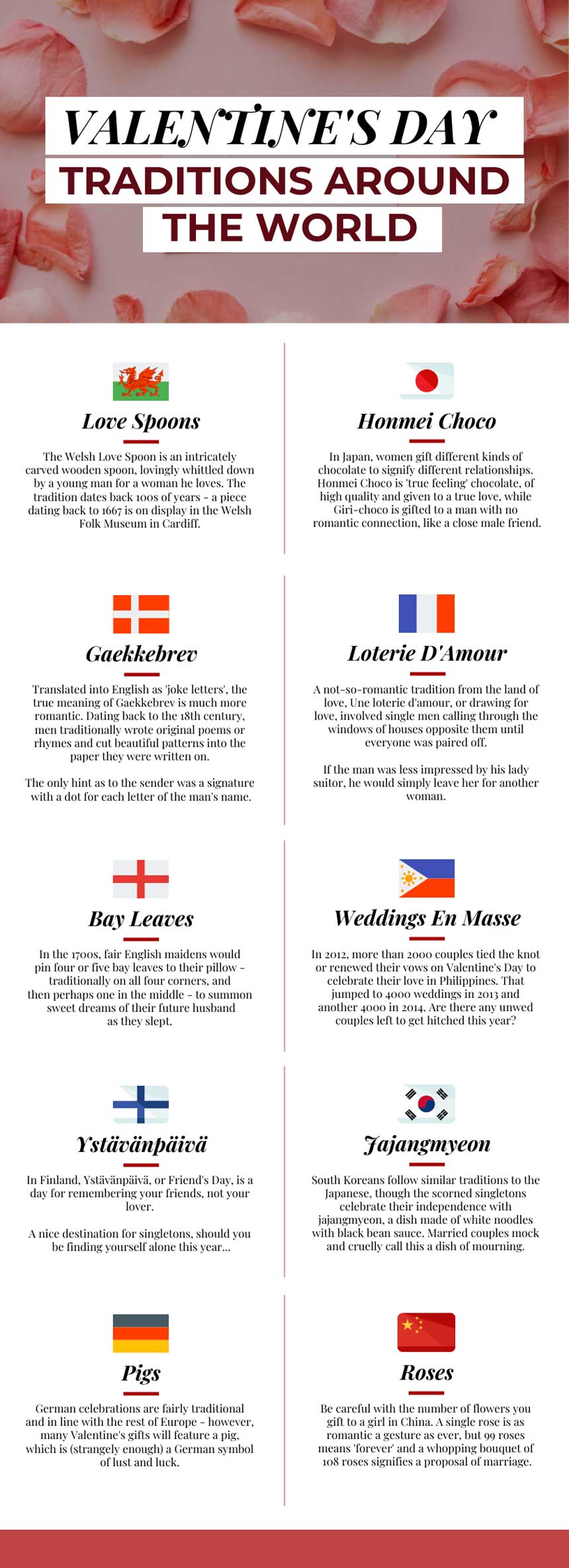
Traditions around the world come from centuries of stories, beliefs, and customs passed down through families and communities. They often start as simple rituals tied to seasons, history, or faith, growing into meaningful celebrations that connect people to their roots. While cultures influence each other over time, these traditions remain a special way for people to honor their past and share something unique with future generations.
Valentine’s Day is celebrated every year on February 14, and this time, it falls on a Friday. All around the world, people exchange candy, flowers, and heartfelt gifts as a way to show love and appreciation—all in honor of St. Valentine.
But who was St. Valentine, and how did these traditions begin? The history of Valentine’s Day traces back to ancient times, from the Roman festival of Lupercalia, which marked the arrival of spring, to the charming tradition of exchanging cards that became popular in Victorian England.
There’s no bad consequence to loving fully, with all your heart. You always gain by giving love.
– Reese Witherspoon, Actress
The Legend of St. Valentine
The origins of Valentine’s Day—and the identity of its namesake—remain wrapped in mystery. While February has long been celebrated as a month of love, the holiday itself blends Christian and ancient Roman traditions.
But who was St. Valentine, and how did he become linked to this romantic occasion?
The Catholic Church recognizes at least three different saints named Valentine or Valentinus, all of whom were martyred. One popular legend tells of a priest named Valentine who lived in third-century Rome. When Emperor Claudius II ruled that single men made better soldiers than those with families, he banned young men from marrying. Believing this decree to be unjust, Valentine secretly performed weddings until he was caught and sentenced to death.
Others claim the true namesake was Saint Valentine of Terni, a bishop who was also executed by Claudius II outside Rome. Regardless of which Valentine inspired the holiday, their stories continue to symbolize love and devotion.
Some stories suggest that Valentine was executed not just for defying the emperor’s marriage ban, but also for helping Christians escape the brutal conditions of Roman prisons, where they were often beaten and tortured. One particularly touching legend claims that while imprisoned, Valentine fell in love with a young girl—possibly the jailer’s daughter—who visited him during his confinement.
Before his execution, he is said to have written her a heartfelt note, signing it “From your Valentine”—a phrase that continues to be used today. Though the true details of his life remain uncertain, the legends paint Valentine as a courageous, compassionate, and deeply romantic figure. By the Middle Ages, his reputation had grown so much that he became one of the most beloved saints in both England and France, forever tying his name to the celebration of love.
Valentine’s Day Greetings and Gifts
Valentine’s Day isn’t just a U.S. tradition—it’s celebrated in countries like Canada, Mexico, the U.K., France, and Australia. In Britain, it gained popularity in the 17th century, and by the mid-18th century, friends and lovers of all social classes were exchanging handwritten notes and small tokens of affection.
By 1900, printed cards became the go-to, thanks to advancements in printing technology. At a time when openly expressing emotions wasn’t always encouraged, ready-made valentines offered a charming and discreet way to share feelings.
Americans likely began exchanging handmade valentines in the early 1700s, but it wasn’t until the 1840s that Esther A. Howland—often called the “Mother of the Valentine”—started selling the first mass-produced versions. Her intricate designs featured real lace, ribbons, and vibrant “scrap” images, setting the stage for the elaborate cards we see today. According to Hallmark, around 145 million Valentine’s Day cards are exchanged each year, making it the second-largest card-sending holiday, right behind Christmas.
Valentine’s Day around the World
Ireland – Love Spoons
The Welsh Love Spoon is a beautifully carved wooden spoon traditionally crafted by a young man as a token of love for his sweetheart. This romantic tradition dates back hundreds of years, with one of the oldest known examples, from 1667, displayed at the Welsh Folk Museum in Cardiff. Each spoon features intricate designs, often including symbols like hearts for love, horseshoes for luck, or knots for eternal togetherness.
These handcrafted tokens weren’t just decorative—they were heartfelt expressions of devotion, making them a cherished part of Welsh heritage.
Japan – Ilonmei Choco
In Japan, Valentine’s Day comes with a unique tradition where women give chocolates to express different types of relationships. Honmei Choco (“true feeling chocolate”) is high-quality chocolate reserved for a romantic partner or someone special. In contrast, Giri Choco (“obligation chocolate”) is given to male friends, colleagues, or acquaintances without romantic intentions.
This custom is followed by White Day on March 14, when men return the favor with gifts, often chocolates, jewelry, or other treats.
Denmark – Gaekkebrev
Gaekkebrev, often translated as “joke letters,” actually carries a much more romantic meaning. Dating back to the 18th century in Denmark and Norway, this tradition involved men writing original poems or rhymes on intricately decorated paper. The poems were meant to be playful and charming, often with beautiful patterns drawn on the paper.
The only clue to the sender’s identity was a series of dots, with each dot representing a letter in the man’s name. If the recipient could correctly guess the sender, they would be gifted a kiss or another token of affection.
France – Lolerie D ‘Amour
Loterie d’Amour (Drawing for Love) is a quirky and somewhat playful tradition from France, rooted in the country’s rich romantic culture. Dating back to the 18th century, single men would call out through the windows of women’s houses, seeking to pair off with them. The idea was for each man to find a partner, but if he wasn’t impressed by his initial choice, he could simply leave her and try his luck with another woman.
This process continued until the women, frustrated by the lack of commitment, would gather together to burn the effigies of the men who had rejected them. While it was an unusual method of matchmaking, it reflected the more carefree and spontaneous aspects of love in that era.
England – Hay Leaves
In 18th century England, a charming tradition involved young women using bay leaves to dream of their future husbands. They would pin four or five bay leaves to the corners of their pillows—sometimes adding one in the center—and then sleep on them with the hope of dreaming about their future spouse.
The idea was that the bay leaves would help summon sweet dreams and perhaps even reveal glimpses of their upcoming marriage. This custom combined elements of romance and superstition, making it a unique part of English folklore.
Philipines – Weddings En Masse
In the Philippines, Weddings En Masse have become a beautiful tradition on Valentine’s Day. Starting in 2002, over 2,000 couples tied the knot or renewed their vows to celebrate their love. This number grew significantly, reaching 4,000 weddings in 2011, and again 4,000 in 2014.
The mass weddings are often organized by local governments or community groups, giving couples the chance to marry in a shared celebration of love. It’s a heartwarming tradition that has become so popular that one might wonder if there are any unwed couples left to wed on Valentine’s Day this year!
Finland – Ystävänpäivä
In Finland, Valentine’s Day is celebrated as Ystävänpäivä, or Friend’s Day, which focuses on honoring your friends rather than romantic partners. It’s a day dedicated to showing appreciation for the important people in your life, whether it’s sending a message, giving small gifts, or simply spending time together.
For those who may find themselves single this year, Finland offers a lovely reminder that Valentine’s Day can be about celebrating friendships and the connections that bring joy and support, making it a perfect destination for singletons.
South Korea – Jajangmyeon
In South Korea, there’s a unique tradition where singletons celebrate Black Day on April 14, a month after Valentine’s Day, by eating Jajangmyeon, a dish made of white noodles served with a savory black bean paste sauce. This tradition is for those who didn’t receive gifts or expressions of affection on Valentine’s Day or White Day (March 14). It’s a way of embracing their single status and finding humor in it.
Interestingly, married couples mockingly refer to the dish as a “meal of mourning” due to its association with loneliness and unrequited love, but for many, it’s a fun and lighthearted celebration of independence.
Germany – Pigs
In Germany, Valentine’s Day gifts often feature an unusual but meaningful symbol: the pig. While German celebrations follow many of the same traditions as the rest of Europe, the pig holds a special place in their romantic customs. It’s a symbol of both lust and luck, making it a fitting and slightly quirky token of affection. You might see pigs made of chocolate, marzipan, or plush toys, which are often given to loved ones on this day to wish them both good fortune and a passionate relationship.
The pig, therefore, adds a playful and charming twist to Valentine’s Day celebrations in Germany.
China – Hoses
In China, the number of roses you gift carries significant meaning. While a single rose is a classic romantic gesture, the meaning behind a larger bouquet can be much more profound. 99 roses symbolize “forever,” expressing eternal love, while a grand bouquet of 108 roses is a bold and clear proposal for marriage.
So, if you plan on sending flowers to someone in China, it’s important to be mindful of the number of roses to ensure your message comes across just as you intend!
Final Words
Roses and chocolate have become iconic gifts for Valentine’s Day because of their long-standing association with love and romance. Roses symbolize love, beauty, and passion, with their deep red color specifically representing deep romantic feelings. Their connection to the holiday dates back centuries, making them a timeless choice to express affection.
On the other hand, chocolate is often linked to indulgence and pleasure, making it a sweet treat to share with loved ones. Its connection to Valentine’s Day was popularized in the 19th century, especially with the rise of mass-produced chocolates, which made it an accessible and delightful gift. Both roses and chocolate have evolved into symbols of love, creating a perfect pairing for celebrating romantic connections on February 14th.


![United Arab Emitaes (UAE) Population Statistics 2024 [Infographic] hero-image-UAE-Population-Statistics-2024](https://www.skillzme.com/wp-content/uploads/2024/11/hero-image-UAE-Population-Statistics-2024-200x200.jpg)
![Dubai Tourism Statistics 2024 [Infographics] hero-image-inforgaphic-Dubai-Tourism-2024](https://www.skillzme.com/wp-content/uploads/2024/11/hero-image-inforgaphic-Dubai-Tourism-2024-200x200.jpg)
![Human Wonder - World's Fastest Trains [Infographic] World's Fastest Trains](https://www.skillzme.com/wp-content/uploads/2025/02/hero-image-Worlds-Fastest-Trains-200x200.jpg)


Recent Comments